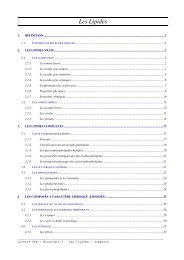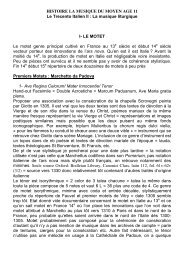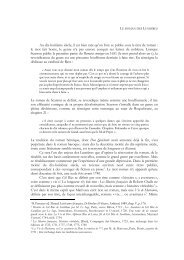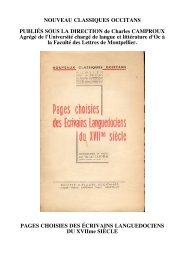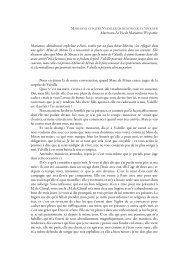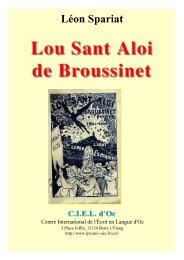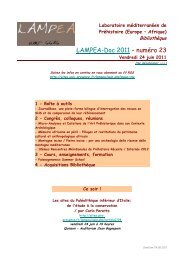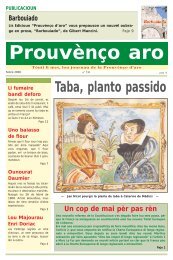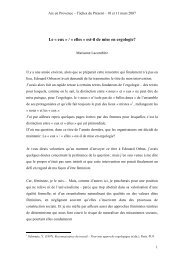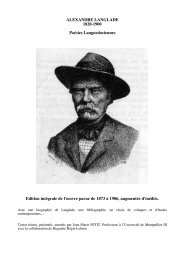Résumés des interventions - Art Nouveau Network
Résumés des interventions - Art Nouveau Network
Résumés des interventions - Art Nouveau Network
You also want an ePaper? Increase the reach of your titles
YUMPU automatically turns print PDFs into web optimized ePapers that Google loves.
Samah ARNOUNI<br />
Aix-Marseille Université<br />
<strong>Art</strong> nouveau à Séoul<br />
La Corée, longtemps surnommée « Le Royaume ermite » par l’Occident, n’a pas<br />
vraiment connu l’influence du style <strong>Art</strong> nouveau sur l’architecture de ses<br />
édifices. Cependant, le pays ayant été colonisé par le Japon entre 1905 et 1945,<br />
il existe quelques bâtiments de style éclectique, alliant architecture baroque et<br />
éléments décoratifs de style <strong>Art</strong> nouveau. Le plus exemple est le temple de<br />
Cheondogyo, situé en plein cœur du quartier traditionnel de Séoul. Cet édifice,<br />
construit entre 1918 et 1921 et <strong>des</strong>siné par l’architecte japonais Nakamura<br />
Yoshibei faisait partie, à son époque, <strong>des</strong> trois plus beaux édifices de la ville.<br />
Jean BAFFIE<br />
CNRS, IrAsia,<br />
L’<strong>Art</strong> <strong>Nouveau</strong> en Thaïlande : une affaire germano-italienne<br />
L’introduction de l’<strong>Art</strong> nouveau au Siam (Thaïlande) fut possible à un moment où<br />
la politique de modernisation dans quasiment tous les domaines n’avait plus guère<br />
à accepter <strong>des</strong> compromissions avec les partisans de la tradition. Après ses<br />
voyages en Europe, le roi Chulalongkorn (1868-1910) voulait européaniser son<br />
pays ; lui succéda le roi Vajiravudh (1910-1925), un roi presque entièrement<br />
formé en Europe, féru de littérature et <strong>des</strong> arts de la scène. L’architecture et la<br />
décoration intérieure connurent un développement prodigieux sous Chulalongkorn<br />
avec la construction de dizaines de palais pour loger ses très nombreux enfants.<br />
Ce sont essentiellement <strong>des</strong> architectes et artistes italiens et allemands qui<br />
introduisirent le style <strong>Art</strong> nouveau au Siam. Le peintre Galileo Chini (1873-1956),<br />
au Siam entre 1911 et 1914, et son élève Carlo Rigoli (1883-1962), actif au Siam<br />
pendant tout le règne de Vajiravudh, ont particulièrement bien réussi à<br />
orientaliser l’<strong>Art</strong> nouveau.<br />
____________________________________________________________<br />
Ingeborg BECKER<br />
Bröhan Museum, Berlin<br />
Poetry and technique: Japanese influence in Scandinavian porcelain at the<br />
turn of the century 1900
Introduction and background<br />
As an aesthetic role model, Japan has played a key role for the artists of<br />
northern Europe. As early as 1885, the pivotal publication by Karl Madsen<br />
“Japansk Malerkunst” appeared in Copenhagen. In 1886, Arnold Krog, the<br />
painter, sculptor and since 1885 the artistic director of the Royal Copenhagen<br />
Porcelain Factory, travelled to Paris to visit the gallery of the Japanese dealer<br />
Siegfried Bing. Krog was accompanied by the Japanese collector William<br />
Salomonsen and they toured Bing's rich collections of Japanese wood carvings<br />
and handicrafts. His collection of woodcut books, as well as the periodical “Le<br />
Japon <strong>Art</strong>istique” published by Bing in 1889 ff., that were to be found there are<br />
testament to his enthusiasm.<br />
Implementation<br />
Under Krog's leadership, the artistic program of the Royal Copenhagen<br />
underwent a major surge in innovation. After 1888, the first porcelain in the new<br />
Japanese style for the “Northern Exhibition” in Copenhagen where he would<br />
present his Japanese objects in his own pavilion. In the period that followed,<br />
Bing became a great broker of the new northern porcelain art.<br />
In the final decade of the 19th century, the Danish porcelain from the Royal<br />
Copenhagen became a paragon of the art nouveau in porcelain for all other<br />
manufacturers as a result of its Japanese decorative work and forms.<br />
Poésie et technique: L'influence japonaise sur l'art de la peinture sur<br />
porcelaine scandinave au tournant du 19è siècle<br />
Introduction et antécédents<br />
L‘art du Japon commença à s'imposer comme modèle esthétique chez les artistes<br />
de l'hémisphère septentrionale aussi. En 1885 déjà, Karl Madsen fit paraître sa<br />
publication fondamentale "Japansk Malerkunst" à Copenhague. En 1886, Arnold<br />
Krog, peintre, sculpteur et directeur artistique de la Manufacture Royale de<br />
Porcelaine de Copenhague depuis 1885, se rendit à Paris pour visiter la galerie de<br />
Siegfried Bing, marchand d'objets d'art japonais. Arnold Krog voyagea en<br />
compagnie de William Salomonsen, collectionneur d'objets d'art japonais. Ils<br />
visitèrent la riche collection de gravures sur bois et d'objets de l'artisanat<br />
d'art japonais de Siegfried Bing. Sa collection d'œuvres sur les gravures sur<br />
bois et le périodique "Le Japon <strong>Art</strong>istique" publié par ses soins en 1889 et dans<br />
les années suivantes (éditions conservées dans la manufacture) témoignent de<br />
son enthousiasme.<br />
Mise en œuvre<br />
Sous la direction d'Arnold Krog, le programme artistique de la manufacture<br />
"Royal Copenhagen" vit une poussée d'innovation incroyable. Depuis 1888, les<br />
premières porcelaines au style japoniste furent mises sur le marché. Dans ce
contexte, on invita Siegfried Bing à présenter ses objets d'art japonais dans son<br />
propre pavillon à l'occasion du "Salon Nordique" de Copenhague. Par la suite,<br />
Siegfried Bing fut le grand ambassadeur du nouvel art de la peinture sur<br />
porcelaine nordique.<br />
Au cours de la dernière décennie du 19è siècle, les porcelaines danoises de la<br />
manufacture "Royal Copenhagen" devenaient le grand modèle de la porcelaine de<br />
l'<strong>Art</strong> nouveau dans toutes les autres manufactures de porcelaine à l'échelon<br />
européen de par leurs décors et formes japonistes.<br />
____________________________________________________________<br />
Ernestine CARREIRA<br />
Aix-Marseille Université<br />
Ma communication portera sur quelques aspects caractéristiques de la céramique<br />
<strong>Art</strong> <strong>Nouveau</strong> qui ont survécu dans une <strong>des</strong> gran<strong>des</strong> capitales mondiales de<br />
l’histoire de la céramique: Lisbonne. Bien que les premières traces de céramique<br />
dans l’actuel territoire portugais remontent à la période de domination<br />
musulmane (VIIIe-XIe siècles), ce furent les manufactures de Séville qui dès le<br />
XVIe siècle ré-introduirent cet art au Portugal. Longtemps importée (Espagne,<br />
Hollande, Chine pour la porcelaine), la production céramique s’est véritablement<br />
enracinée au XVIIIe siècle en développant ses propres spécificités techniques<br />
et artistiques, en particulier l’omniprésence de la monochromie du bleu/blanc<br />
(influence chinoise et hollandaise). Cette dernière reste encore aujourd’hui une<br />
<strong>des</strong> gran<strong>des</strong> bases de la production artisanale.<br />
Ce fut également, et pratiquement exclusivement, par l’architecture et la<br />
céramique (azulejo et porterie) que le Portugal participa à la fin du XIXe siècle à<br />
la nouvelle vogue de l’<strong>Art</strong> <strong>Nouveau</strong>. Regrettablement peu étudié encore,<br />
complètement ignoré <strong>des</strong> circuits touristiques du patrimoine artistique, l’azulejo<br />
<strong>Art</strong> <strong>Nouveau</strong> reste pourtant une <strong>des</strong> richesses artistique <strong>des</strong> faça<strong>des</strong> de<br />
Lisbonne.<br />
Cette communication, non élaborée par une spécialiste d’histoire de l’<strong>Art</strong>,<br />
montrera les principales caractéristiques reconnues de la céramique <strong>Art</strong> <strong>Nouveau</strong><br />
au Portugal et les liens possibles que la recherche future pourra établir avec la<br />
production et les influences asiatiques. Si le Portugal a largement été plus un<br />
importateur de produits et concepts orientaux qu’un espace de rayonnement<br />
dans ce domaine, il convient de ne pas oublier que les innovations techniques<br />
portugaises en matière de céramique ont pu sans difficulté voyager de Lisbonne<br />
à Macao jusqu’au XXe siècle.
____________________________________________________________<br />
Sarah COULOUMA<br />
Aix-Marseille Université<br />
Canton et l’<strong>Art</strong> nouveau<br />
Des commerçants étrangers s’installent à Canton (ou Guangzhou) dès le XVIe<br />
siècle, mais c’est après la signature du traité de Nankin que les comptoirs de<br />
négoces européens seront les plus nombreux. Des quartiers entiers se forment<br />
alors, où les commerçants étrangers se regroupent et construisent plusieurs<br />
édifices entre 1880 et 1920 : églises, banques, hôtels et clubs privés fleurissent.<br />
Dans les quartiers du lac Liwan et de l’île de Shamian – aujourd’hui devenus très<br />
touristiques –, les gran<strong>des</strong> bâtisses d’époques ont été préservées et offrent<br />
plusieurs exemples d’architecture et de décorations relevant du courant <strong>Art</strong><br />
nouveau. Après un bref historique de ces quartiers, nous présenterons <strong>des</strong><br />
exemples concrets de la mouvance <strong>Art</strong> nouveau à Canton, principalement à partir<br />
<strong>des</strong> ouvrages de ferronnerie que l’on y trouve.<br />
Canton and <strong>Art</strong> nouveau<br />
Foreign merchants started to settle in Canton (Guangzhou) in the sixteenth<br />
century, but it was after the Treaty of Nanking that the European wholesalers<br />
were the most numerous. Entire neighborhoods were then formed, where foreign<br />
merchants lived together and built several buildings between 1880 and 1920:<br />
churches, banks, hotels and private clubs flourished. In Liwan Lake District and<br />
on Shamian Island – both areas have been transformed in touristic attractions –,<br />
most of the mansions of this period have been preserved and they provide<br />
several examples of <strong>Art</strong> nouveau <strong>des</strong>ign, in the architecture and the decorations<br />
of the buildings. After a brief history of these areas, we will present examples<br />
of the <strong>Art</strong> <strong>Nouveau</strong> movement in Canton, mainly found in decorative ironworks.<br />
____________________________________________________________<br />
Mirjam DENES,<br />
Université Eötvös, Budapest,<br />
Sha<strong>des</strong> of Japonisme in Hungarian Set and Costume Designs<br />
The impact of Japanese art on Europe from the second half of the nineteenth<br />
century was not only present in fine and applied arts but in dramatic arts and<br />
entertainment industry as well. Dramas, operas, operettas and musical comedies
were written by English, French, Italian, Spanish and Hungarian authors and<br />
composers, all set in the exotic Japan. In my paper I discuss the effect of<br />
Japanese art on Hungarian set and costume <strong>des</strong>igns used in various plays on show<br />
between 1886 and 1936 (beginning with the Hungarian premier of The Mikado by<br />
Gilbert & Sullivan and finishing with The Ronins' Treasure, drama written by<br />
Miklós Kállay and inspired by the famous Japanese story, Chūshingura). With the<br />
help of a great amount of yet unpublished <strong>des</strong>igns and archive photographs<br />
concerning the above mentioned Hungarian performances and their visual<br />
sources, I distinguish between different terms used in connection with Japanese<br />
influence on European art: Japonerie, Japonaiserie and Japonisme. By doing so I<br />
wish to show that the notion of Japonisme have had various sha<strong>des</strong> in Hungarian<br />
theatre, and that the use of each notion depended as much on the taste of the<br />
audience as on the intentions of set and costume <strong>des</strong>igners.<br />
Les nuances du japonisme dans les décors et les costumes hongrois<br />
L'influence de l'art japonais sur l'Europe, à partir de la seconde moitié du<br />
XIXème siècle, n'était pas seulement présente dans les beaux-arts et les arts<br />
appliqués mais aussi dans l’art dramatique et dans l'industrie du spectacle. Des<br />
drames, <strong>des</strong> opéras, <strong>des</strong> opérettes et <strong>des</strong> comédies musicales ont été écrits par<br />
<strong>des</strong> compositeurs anglais, français, italiens, espagnols et hongrois, tous étant<br />
mises en scène dans l'environnement exotique du Japon. Mon article traite de<br />
l'effet de l'art japonais sur les décors et les costumes utilisés dans le théâtre<br />
hongrois entre 1886 et 1936 (en commençant par « Le Mikado » par Gilbert et<br />
Sullivan, et en terminant par « Le trésor <strong>des</strong> Ronins », écrite par Miklós Kállay et<br />
inspirée par la célèbre histoire japonaise, Chūshingura). En s’appuyant sur une<br />
grande quantité de photographies, de <strong>des</strong>sins et d'archives inédits, concernant<br />
les performances hongroises mentionnées ci-<strong>des</strong>sus et leurs sources visuelles, je<br />
vais distinguer les différentes notions utilisées pour décrire l'influence<br />
japonaise sur l'art européen : japonerie, japonaiserie et japonisme. Ainsi, je vais<br />
essayer de prouver que la notion de japonisme a connu <strong>des</strong> diverses nuances dans<br />
le théâtre hongrois, dépendant autant du goût du public que de l’intention <strong>des</strong><br />
décorateurs et <strong>des</strong> costumiers.<br />
____________________________________________________________<br />
Michel DOLINSKI<br />
Aix-Marseille Université<br />
L’<strong>Art</strong> nouveau à HCMV, Viêt Nam
Alors que le Viêt Nam est sous domination française, l’art nouveau qui fleurit<br />
dans toute l’Europe, trouve aussi un écho dans cette colonie asiatique. Notre<br />
travail explorera différentes expressions de ce mouvement dans l’espace urbain<br />
de l'ancienne Saïgon, aujourd'hui Ho Chi Minh Ville.<br />
____________________________________________________________<br />
Katalin GELLER,<br />
Institut d’Histoire de l’<strong>Art</strong> de l’Académie <strong>des</strong> Sciences,Budapest, Hongrie<br />
Un modèle centre-européen du japonisme<br />
L’étude présente la diversité <strong>des</strong> oeuvres nées sous l'impact du japonisme en<br />
Hongrie au tournant du 19e et 20e siècle ainsi que leurs traits caractéristiques à<br />
peine étudiés. Il n'y avait pas d’artistes hongrois dont le style était fortement<br />
influencé par l'art japonais. L'impact du japonisme a pourtant contribué au<br />
renouvellement de l'art en Hongrie. L'épanouissement du japonisme après 1900<br />
en Hongrie se caractérise par le fait qu’il est arrivé sur la scène artistique<br />
hongroise, dans beaucoup de cas, par l’intermédiaire <strong>des</strong> oeuvres<br />
impressionnistes, art nouveau et post-impressionniste, c'est-à-dire <strong>des</strong> oeuvres<br />
de Monet, de Beardsley et de Van Gogh. Le japonisme en Hongrie avait une<br />
interprétation spéciale aussi, basée sur la tradition romantico-nationale à la fois<br />
historique, mythique et imaginaire concernant les origines orientales <strong>des</strong><br />
Magyares.<br />
A Central-European Model of Japonisme<br />
I would like to present the diversity of approaches and the characteristic<br />
aesthetic features of the impact of Japonisme in Hungary at the turn of the<br />
century. Japonisme appeared in Hungarian art in various guises, yet the topic has<br />
not been researched up to now. There is no other Hungarian artists whose main<br />
guiding principle would have been Japonisme, still Japonisme greatly contributed<br />
to the rejuvenation of Hungarian art. After 1900 what characterised flourishing<br />
Japonisme here was the fact that it was propagated by Impressionist, <strong>Art</strong><br />
<strong>Nouveau</strong> and Post-Impessionist painters and graphic artists, like Monet, Van<br />
Gogh and Beardsley who all played an important mediating role. Japonisme also<br />
had a special regional interpretation based on the historical, mythical and<br />
imaginative tradition related to the oriental roots of Hungarians.<br />
____________________________________________________________<br />
Olivier JUSTAFRE,
Archives départementales <strong>des</strong> Côtes d'Armor<br />
Les reliures japonisantes (1885-1900) : passerelle entre japonisme et art<br />
nouveau ?<br />
Il peut sembler surprenant que jusqu’à présent les reliures japonisantes n’aient<br />
jamais fait l’objet d’une étude spécifique. Fort prisées dès le milieu <strong>des</strong> années<br />
1880, et ce notamment grâce à l’influence d’éminents bibliophiles tels que les<br />
frères Goncourt, Philippe Burty ou encore Octave Uzanne, l’engouement qu’elles<br />
suscitèrent fut aussi intense que bref. Nous présenterons l’histoire et les<br />
techniques de fabrication de ce matériau habituellement décrit par les<br />
bibliophiles comme un « cuir japonais » et qui n’a en réalité de cuir que le nom.<br />
Nous nous pencherons ensuite sur sa commercialisation en Europe, et tout<br />
particulièrement en France où Samuel Bing, notamment, sut faire découvrir et<br />
apprécier cette matière. En s’appuyant entre autres sur le cas très révélateur du<br />
Miroir du Monde d’Octave Uzanne, nous entreverrons la grande diversité <strong>des</strong><br />
types de « cuirs japonisants » qu’il est possible de rencontrer.<br />
Enfin, nous aborderons les liens qui unissent, dans le milieu de la bibliophilie,<br />
japonisme et art nouveau.<br />
Japanese bindings (1885-1900) : a link between "japonisme" and "art<br />
nouveau" ?<br />
It may be surprising that the Japanese bindings have not been studied until<br />
these days. Specially appreciated from the middle of the 1880's, thanks to the<br />
influence of eminent bibliophiles such as the Goncourt brothers, Philippe Burty<br />
or Octave Uzanne. This enthousiasm was as intense as brief. We'll introduce the<br />
history and the way of making this kind of material usually <strong>des</strong>cribe as<br />
"Japanese leather" by the bibliophiles. In fact, this is not leather at all. Then,<br />
we'll talk about its marketing in Europe and especially in France where Samuel<br />
Bing revealed and created a real enthousiasm for this material. With the help of<br />
the very significant case of the Octave Uzanne’s book " le Miroir du monde",<br />
we'll see the large variety of "Japanese leathers" types that may exist.<br />
Finally, we'll approach the connections between "japonisme" and "art nouveau" in<br />
the little world of the bibliophiles.<br />
____________________________________________________________<br />
Katalin KESERU<br />
Institut d’Histoire de l’<strong>Art</strong>, Université Eötvös Lớrảnd, Budapest, Hongrie.
Indian-Hungarian Style of <strong>Art</strong> <strong>Nouveau</strong> Architecture in Hungary<br />
The openness of Western <strong>Art</strong> <strong>Nouveau</strong> could be represented by the canonization<br />
of different kinds of art into the realm of European high culture. At the same<br />
time, European art has got several ‘new’ ideas from the different cultural<br />
traditions such as art of the peasants and Eastern nations.<br />
Regarding architecture, Ödön Lechner was one of the early representatives of<br />
the Hungarian <strong>Art</strong> <strong>Nouveau</strong> movement. For Lechner – having studies in Berlin,<br />
practiced in France, as well as completed tours in Italy and Great Britain – his<br />
flowering period, in the two deca<strong>des</strong> at the turn of the century, coincided with<br />
that of the nation, which was working out its own ‘language’, stumbling out of the<br />
past and eager to communicate with the world. Regarding architecture as a<br />
national vital sign, Lechner showcased the range of Hungarian culture in his<br />
buildings with their architectural forms, plastic arrangement, special materials<br />
(ceramics), and his motifs of peasant art, Eastern in origin according to the<br />
researches of the time on the past of the Magyar. He combines folk and Indian<br />
elements with the use of historical European forms and modern materials at his<br />
time, such as steel, glass, pirogranit and concret.<br />
By revaluating vernacular motifs, he elevated them and placed them into the<br />
realm of monumental architecture. By searching for a connection between<br />
Eastern ornamentation and European forms he and his followers created a<br />
special Indianism in architecture and also a bridge between the western and<br />
eastern perceptions of architecture.<br />
____________________________________________________________<br />
Shiyan LI<br />
AixMarseille Université<br />
La beauté du diable de Beardsley et sa réception en Chine<br />
Aubrey Beardsley est considéré comme l'un <strong>des</strong> contributeurs importants de<br />
l'<strong>Art</strong> <strong>Nouveau</strong>. On sait que ses illustrations ont été en partie inspirées par l'art<br />
japonais. Je voudrais aussi montrer que, dans les années 1920, ses oeuvres sont<br />
introduites en Chine dans le milieu littéraire où elles exercent une séduction<br />
remarquable. Mon intervention consistera à élucider la manière dont Beardsley<br />
utilise les ressources de l'Ukiyoe (quels sont les éléments plastiques de l'art<br />
japonais retenus par Beardsley ? N'y-a-t-il pas une concordance de pensée entre<br />
un Beardsley qui provoque le « grotesque » et un Hokusai qui évoque l'« enfer »<br />
?) D'autre part, j'aborderai dans un deuxième temps la réception de l'art de<br />
Beardsley par les écrivains chinois dans les années 1920. Pourquoi Lu Xun, qui<br />
pourtant préconisait un art engagé (par exemple, celui de Käthe Kollwitz) a publié
un recueil de douze <strong>des</strong>sins de Beardsley en évoquant leur « beauté diabolique »<br />
? Quels sont les enjeux de cette publication ? Pour quelle raison l'art de<br />
Beardsley disparaît dans les années 1930 de la scène chinoise ? Les lettrés<br />
chinois de cette époque ne détectent-ils pas une sensibilité décadente chez cet<br />
artiste qui serait potentiellement dangereuse pour la construction d'une<br />
modernité chinoise ? Autour de l'oeuvre de Beardsley on s'aventurera à mettre<br />
en lumière un jeu d'emprunts, d'échanges mutuels entre l'Occident et<br />
l'ExtrêmeOrient par lesquels l'histoire se constitue, les regards se croisent.<br />
Beardsley's beauty of devil and its reception in China<br />
Aubrey Beardsley is considered as one of the most important contributors to<br />
<strong>Art</strong> <strong>Nouveau</strong>. We know that his illustrations were partly inspired by Japanese<br />
art. I also want to show that, in the 1920s, his works were introduced in China<br />
into the literary world in which they had a remarkable attraction. My paper will<br />
elucidate how Beardsley used the resources of the Ukiyoe (what were the visual<br />
elements of Japanese art held by Beardsley? Was there a concordance between<br />
Beardsley’s "grotesque" and Hokusai’s "hell"?) On the other hand, I will discuss<br />
in a second time the reception of Beardsley's art by Chinese writers in the<br />
1920s. Why Lu Xun, who supported a political commitment (like in Käthe<br />
Kollwitz's art) published a collection of twelve drawings of Beardsley and<br />
mentioned their "diabolical beauty"? What were the stakes of this publication?<br />
Why Beardsley's art disappeared in the 1930s on the Chinese scene? Did<br />
Chinese scholars of that time detect in this art a sensibility of decadence which<br />
would be potentially dangerous for the construction of a chinese modernity?<br />
Around the Beardsley’s work we will venture to highlight a set of loans, the<br />
mutual exchanges between the West and the Far East’s cultures by which the<br />
cultural history developped and the gazes intersected.<br />
____________________________________________________________<br />
Pierre MARTIN<br />
Aix-Marseille Université<br />
La culture de Taiwan, le carreau de pavement asiatique et l’<strong>Art</strong> <strong>Nouveau</strong><br />
européen<br />
Au tournant du siècle et jusqu'à la 2e guerre mondiale, les Japonais se mettront<br />
à la production de carreaux colorés souvent très influencés par l’<strong>Art</strong> <strong>Nouveau</strong><br />
européen, d’abord sous forme de copies manifestes de modèles européens et<br />
surtout anglais, puis peu à peu développant <strong>des</strong> iconographies et un style de plus
en plus originaux. Ces carreaux ne seront pas très populaires auprès <strong>des</strong><br />
Japonais mais vont en revanche connaître un engouement extraordinaire auprès<br />
d’autres communautés, par exemple la communauté chinoise en Asie. Je<br />
présenterai plusieurs exemples de ces carreaux japonais et leur utilisation<br />
originale et particulière à Taiwan en architecture et dans la vie de tous les jours.<br />
The Culture of Taiwan, Tile Pavement in Asia and European <strong>Art</strong> <strong>Nouveau</strong><br />
At the turn of the century until the Second World War the Japanese will<br />
produce colored tiles often heavily influenced by European <strong>Art</strong> <strong>Nouveau</strong>, first as<br />
obvious copies of European and English models, then developing little by little an<br />
iconography and a style much more original. These tiles were not very popular<br />
with the Japanese but will be very well received in other communities, for<br />
example the Chinese community in Asia. I will present several examples of these<br />
tiles and their original and particular use in Taiwan in architecture and everyday<br />
life.<br />
____________________________________________________________<br />
Pierre MARTIN<br />
L’essor économique de Montréal et l’<strong>Art</strong> <strong>Nouveau</strong> au tournant du 20e siècle<br />
Au tournant du 20e siècle, Montréal est la capitale économique du tout nouveau<br />
Canada fondé en 1867. L’<strong>Art</strong> <strong>Nouveau</strong>, européen mais aussi américain (Tiffany,<br />
etc.), sera utilisé par l’élite anglaise de Montréal pour montrer leurs succès. Je<br />
présenterai <strong>des</strong> exemples d’<strong>Art</strong> <strong>Nouveau</strong> en architecture et aussi en art<br />
décoratif que l’on retrouve à Montréal.<br />
The economic growth of Montreal and <strong>Art</strong> <strong>Nouveau</strong> at the turn of the 20th<br />
century<br />
At the turn of the 20th century, Montreal is the economic capital of the newly<br />
founded Canada in 1867. The European but also American <strong>Art</strong> <strong>Nouveau</strong> (Tiffany,<br />
etc.) will be used by the English-speaking elite of the city to show their success.<br />
I will present examples of <strong>Art</strong> <strong>Nouveau</strong> architecture and decorative art as found<br />
in Montreal.<br />
____________________________________________________________<br />
Breda MIHELIC<br />
Institut d’urbanisme de la RS Ljubljana, Slovenia
RIFFAUD-BUFFAT Anne-Sophie,<br />
Réseau <strong>Art</strong> <strong>Nouveau</strong> <strong>Network</strong>, Bruxelles, Belgique<br />
14 ANS DU RESEAU ART NOUVEAU NETWORK<br />
L’idée de créer un réseau européen pour encourager les recherches, la<br />
promotion et la préservation du patrimoine <strong>Art</strong> nouveau au niveau paneuropéen, a<br />
été lancée par la Direction <strong>des</strong> Monuments et <strong>des</strong> Sites de la Région bruxelloise<br />
en 1998. Le réseau, qui réunissait 7 villes européennes il y a 14 ans, rassemble<br />
aujourd’hui 22 villes au sein d’une association de réputation internationale.<br />
L’objet de la conférence est la présentation <strong>des</strong> activités du réseau, <strong>des</strong> trois<br />
grands projets réalisés depuis sa fondation dans le cadre du programme Culture<br />
2000, et du quatrième en cours. Ce projet européen intitulé « <strong>Art</strong> nouveau &<br />
écologie » (2010-2015) propose un focus sur l’inspiration qu’a été la nature pour<br />
ce mouvement, notamment à travers l’exposition itinérante « Natures de l’<strong>Art</strong><br />
nouveau », déclinée en deux fac-similés, qui sera inaugurée à Helsinki et<br />
Bruxelles début octobre 2013. Soutenu par le programme Culture 2007-2013 de<br />
la Commission européenne, ce projet permet également au Réseau d'organiser<br />
<strong>des</strong> colloques, <strong>des</strong> échanges entre professionnels européens et <strong>des</strong> outils<br />
pédagogiques.<br />
Cette présentation exposera également les opportunités de travailler ensemble<br />
en groupe et dans un contexte aussi différencié, évoquera les possibilités de<br />
coopération et de financement et présentera les projets pour le futur.<br />
Elizabeth NAUDOU<br />
Aix-Marseille Université<br />
« Palais princiers et <strong>Art</strong> nouveau en Inde »<br />
L’<strong>Art</strong> nouveau a été introduit en Inde sous l’influence <strong>des</strong> architectes européens,<br />
maîtres d’œuvre <strong>des</strong> palais princiers datant de la fin du XIXe et du début du<br />
XXe siècle. Les diverses techniques liées au travail de l’émail, du bois, du verre<br />
et du fer ont été appliquées à la décoration intérieure de ces riches demeures,<br />
en privilégiant les motifs et thèmes iconographiques de la mythologie hindoue.
Les gran<strong>des</strong> dynasties de maharajas et maharanis ont privilégié les<br />
représentations religieuses sur les parois de leurs palais dans un nouveau style<br />
d’art, unique, en réaffirmant ainsi leur souveraineté suprême et leur<br />
appartenance au monde <strong>des</strong> dieux.<br />
____________________________________________________________<br />
Marielle RICHON<br />
Consultante, Unesco<br />
<strong>Art</strong> <strong>Nouveau</strong> and the World Heritage Convention<br />
Introduction: Brief Description of the World Heritage Convention and its<br />
paradigm, the Outstanding Universal Value (OUV).<br />
Analysis of <strong>Art</strong> <strong>Nouveau</strong> in the World Heritage List and National Tentative<br />
Lists. Is <strong>Art</strong> <strong>Nouveau</strong> well represented? How should it be represented? Which<br />
types of <strong>Art</strong> <strong>Nouveau</strong> styles are represented on the World Heritage List.<br />
Analysis of the National Tentative Lists. Which States Parties are integrating<br />
<strong>Art</strong> <strong>Nouveau</strong> into their national strategies?<br />
Are there future serial nominations including <strong>Art</strong> <strong>Nouveau</strong> properties?<br />
Which <strong>Art</strong> <strong>Nouveau</strong> properties which do not appear yet in Tentative Lists could<br />
have the OUV and justify their nomination for inscription on the World Heritage<br />
List?<br />
Conclusion<br />
L'<strong>Art</strong> <strong>Nouveau</strong> et la Convention du patrimoine mondial<br />
Introduction: Brève <strong>des</strong>cription de la Convention du patrimoine mondial et son<br />
paradygme la Valeur Universelle Exceptionnelle (VUE)<br />
Analyse de l'<strong>Art</strong> <strong>Nouveau</strong> dans la Liste du patrimoine mondial et dans les listes<br />
indicatives nationales. L'<strong>Art</strong> <strong>Nouveau</strong> y est-il bien représenté? Quels styles<br />
d'<strong>Art</strong> <strong>Nouveau</strong> sont représentés dans la Liste du patrimoine mondial.<br />
Analyse <strong>des</strong> listes indicatives nationales. Quels Etats parties ont intégré l'<strong>Art</strong><br />
nouveau dans leurs stratégies nationales?
Existe-t-il <strong>des</strong> propositions d'inscriptions futures comprenant <strong>des</strong> biens <strong>Art</strong><br />
<strong>Nouveau</strong>?<br />
Quels biens <strong>Art</strong> <strong>Nouveau</strong> ne figurant pas encore sur les listes indicatives<br />
pourraient posséder la VUE et justifier leur proposition d'inscription sur la Liste<br />
du patrimoine mondial?<br />
Conclusion<br />
____________________________________________________________<br />
Christine SHIMIZU<br />
Musée Cernuschi, Paris.<br />
L’<strong>Art</strong> <strong>Nouveau</strong> au Japon : un exemple de réappropriation artistique<br />
L’adaptation de schémas artistiques japonais en France donna naissance à l’<strong>Art</strong><br />
<strong>Nouveau</strong>. Venus à l’Exposition universelle de Paris de 1900, <strong>des</strong> artistes japonais<br />
découvrirent cette interprétation et rapportèrent chez eux <strong>des</strong> affiches et <strong>des</strong><br />
imprimés de l’Exposition. Ce style fut adopté par <strong>des</strong> peintres, <strong>des</strong> décorateurs,<br />
<strong>des</strong> céramistes. L’assimilation fut rapide, car il s’agissait parfois d’un retour de<br />
formes et de thèmes propres à l’art japonais. Au cours de cette présentation,<br />
nous montrerons comment les artistes japonais retrouvèrent leurs traditions au<br />
travers du prisme de l’<strong>Art</strong> <strong>Nouveau</strong> occidental. Les thèmes, les compositions et<br />
les stylisations seront ici abordés.<br />
____________________________________________________________<br />
Mika TANAKA<br />
Faculté <strong>des</strong> Sciences et Technologie, Tokyo,<br />
Les architectes japonais et l’<strong>Art</strong> nouveau<br />
Je présenterai deux grands architectes japonais qui ont exploité les motifs de l’<strong>Art</strong><br />
<strong>Nouveau</strong> au Japon dans l’architecture japonaise à l’époque Meiji (1868-1912) et<br />
Taisho (1912-1926) après s’être initiés aux styles occidentaux au cours de leurs
étu<strong>des</strong> et voyages en Europe. Il s’agit de Kingo Tatsuno (1854-1919) et Goichi<br />
Takeda (1872-1938), l’un de ses disciples.<br />
Japanese architects and <strong>Art</strong> nouveau<br />
I will introduce two major Japanese architects who had operated the style of <strong>Art</strong><br />
<strong>Nouveau</strong> in Japan on japanese architecture in Meiji (1868-1912) and Taisho (1912-<br />
1926), after their studies in europeen styles through their travels in Europe. They are<br />
Kingo Tatsuno (1854-1919) and Goichi Takeda (1872-1938), who was one of his<br />
disciples.<br />
____________________________________________________________<br />
Véronique THUIN<br />
Université de Nice<br />
L’art nouveau à Nice : <strong>des</strong> détails qui ont leur importance.<br />
Si Nice est un espace où l’activité du bâtiment connaît un essor spectaculaire<br />
dans la seconde moitié du XIXème siècle, elle n’apparaît cependant pas comme un<br />
lieu de l’avant-garde pour la création architecturale. La ville manifeste plutôt un<br />
certain conformisme, par delà la fantaisie « attendue » dans les stations de<br />
villégiature. Si à la fin du XIXème siècle le style « Belle Epoque » s’impose<br />
comme dominant et se maintient même, dans une large mesure, après la Première<br />
Guerre mondiale, les tendances « art nouveau » ne sont cependant pas absentes.<br />
Elles trouvent souvent leur place dans les édifices grâce aux métiers d’art, (<strong>des</strong><br />
ferronnerie, <strong>des</strong> vitaux, <strong>des</strong> boiseries, <strong>des</strong> céramiques, <strong>des</strong> fresques… ) On<br />
rencontre cependant <strong>des</strong> architectes qui tentent de donner à ces formes<br />
nouvelles une plus grande lisibilité au travers de certains édifices. Il conviendra<br />
de se demander dans quelle mesure ces œuvres sont liées à la présence, dans<br />
cette ville éminemment cosmopolite, de personnages sensibilisés aux civilisations<br />
asiatiques.<br />
__________________________________________________________________________________<br />
TRAN QUOC BAO,<br />
Ecole nationale supérieure de génie civil ENSG, Hanoi, Vietnam<br />
ART NOUVEAU ARCHITECTURE IN HANOI
The introduction mentions to the role of French quarter and Colonial architecture,<br />
including <strong>Art</strong> <strong>Nouveau</strong> in Hanoi’s current urban space and the future planning approved<br />
by Viet Nam government.<br />
The research will discuss about the following questions:<br />
- What architects force and why did they put <strong>Art</strong> <strong>Nouveau</strong> into Ha Noi? It is an<br />
interesting question because there are many fragments of <strong>Art</strong> <strong>Nouveau</strong> existing in<br />
buildings of Academic style during French colonial age.<br />
- The process of taking shape and developing through space and timeline of <strong>Art</strong><br />
<strong>Nouveau</strong> in Hanoi. How was it Vietnamese adapted? How was the symbiotic in Hanoi<br />
architecture?<br />
- <strong>Art</strong> <strong>Nouveau</strong> in types of building in Hanoi and their scales? What types of <strong>Art</strong><br />
<strong>Nouveau</strong> were commonly used in Hanoi? That may be an identity of Hanoi <strong>Art</strong> <strong>Nouveau</strong>,<br />
due to a preliminary monitoring that <strong>Art</strong> <strong>Nouveau</strong> was performed in many buildings with<br />
different functions and scales in various ways.<br />
- Evaluating the existent of Hanoi <strong>Art</strong> <strong>Nouveau</strong> architecture and the ability to<br />
conservation these heritages in the process of Hanoi’s urban space developing.<br />
KIẾN TRÚC ART NOUVEAU Ở HÀ NỘI<br />
Phần mở đầu bài viết sẽ đề cập tới vai trò của Khu phố Pháp và kiến trúc Pháp thuộc<br />
(architecture colonial) trong đó có kiến trúc <strong>Art</strong> <strong>Nouveau</strong> đối với không gian đô<br />
thị Hà Nội hiện nay và quy hoạch Hà Nội trong tương lai đã được chính phủ Việt<br />
Nam phê duyệt.<br />
Phần nghiên cứu sẽ đề cập tới các vấn đề (question) sau:<br />
- Những thế lực kiến trúc sư nào và vì sao họ lại đưa phong cách <strong>Art</strong> <strong>Nouveau</strong><br />
vào Hà Nội? Đây là vấn đề khá thú vị vì có rất nhiều chi tiết (fragment) <strong>Art</strong><br />
<strong>Nouveau</strong> hiện tồn tại ở các công trình kiến trúc theo phong cách Kinh viện (style<br />
académique) thời Pháp thuộc.<br />
- Quá trình hình thành và phát triển theo thời gian và không gian của Kiến<br />
trúc <strong>Art</strong> <strong>Nouveau</strong> ở Hà Nội. <strong>Art</strong> <strong>Nouveau</strong> ở Hà Nội đã được Việt Nam hóa như thế<br />
nào, hiện tượng cộng sinh (symbiose) trong kiến trúc ở Hà Nội?
- Kiến trúc <strong>Art</strong> <strong>Nouveau</strong> ở các thể loại công trình và quy mô công trình ở Hà<br />
Nội, các hình thức (type) <strong>Art</strong> <strong>Nouveau</strong> nào được được sử dụng nhiều ở Hà Nội? Đây<br />
có thể là một nét đặc trưng của Kiến trúc <strong>Art</strong> <strong>Nouveau</strong> Hà Nội, vì theo quan sát sơ<br />
bộ phong cách <strong>Art</strong> <strong>Nouveau</strong> được thể hiện ở nhiều công trình có công năng khác<br />
nhau, có quy mô khác nhau dưới nhiều hình thức khác nhau.<br />
- Đánh giá hiện trạng Kiến trúc <strong>Art</strong> <strong>Nouveau</strong> ở Hà Nội và khả năng bảo tồn di<br />
sản Kiến trúc <strong>Art</strong> <strong>Nouveau</strong> trong quá trình phát triển không gian đô thị Hà Nội.<br />
___________________________________________________________________<br />
Jos VANDENBREEDEN<br />
Architecture Archive – Belgique,<br />
La nature et les structures dans l’architecture de l’<strong>Art</strong> nouveau. Influences<br />
japonaises dans la conception de l’espace de Victor Horta<br />
La période à partir de 1880 est marquée par une fascination pour différentes formes<br />
de l’art japonais et de l’architecture japonaise, fascination qui se fait jour<br />
parallèlement à l’avant-gardisme belge. Émile Tassel, l’un <strong>des</strong> premiers clients de<br />
Victor Horta, possédait une riche collection d’art japonais, doublée d’une bibliothèque<br />
de référence complète. L’art japonais évoque la nature ; de même, la maison<br />
japonaise séjourne tout près de la nature, l’absorbe et lui répond. Un intérieur<br />
japonais ne requiert pas seulement la présence physique de l’homme, mais tout<br />
autant sa participation intellectuelle. La maison japonaise traditionnelle est constituée<br />
d’une ossature en bois dont les vi<strong>des</strong> sont comblés par <strong>des</strong> parois légères, fixes ou<br />
coulissantes. Des parois coulissantes donnant sur l’extérieur font pour ainsi dire<br />
entrer la nature au sein de la maison. Elles créent ainsi un espace intermédiaire (un<br />
espace de transition) entre l’extérieur et l’intérieur. Par un « retournement », Horta<br />
prend ces principes japonais pour ainsi dire à rebours en faisant de l’intérieur de la<br />
maison de ville un milieu naturel. L’évocation de la nature vivante est en effet l’un<br />
<strong>des</strong> éléments les plus fondamentaux de son architecture, élément dans lequel les<br />
influences japonaises sont prégnantes. Parce que ses habitations ne sont portés que<br />
par une ossature métallique, Horta est en mesure de développer un système<br />
constructif inédit. Aux murs non porteurs, il peut substituer <strong>des</strong> parois légères, <strong>des</strong><br />
vitraux, <strong>des</strong> panneaux coulissants. C’est ainsi qu’il met au point un ‘plan libre’,<br />
reposant sur un système constructif et spatial. Cependant, et bien que la plupart <strong>des</strong>
aspects formels de l’oeuvre de Horta puissent être mis en relation avec l’influence<br />
japonisante, j’estime qu’il s’agit avant tout chez lui d’une influence sur le plan<br />
conceptuel.<br />
The nature and structures in the architecture of the <strong>Art</strong> <strong>Nouveau</strong>. Japanese<br />
influences in the space’s <strong>des</strong>ign of Victor Horta<br />
The period from 1880 was characterized in Belgium by a fascination with different<br />
forms of Japanese art and architecture, which were related to Belgian avant-gardism.<br />
One of Victor Horta’s first clients, Emile Tassel, had an important collection of<br />
Japanese art. Japanese art evokes nature, but the ultimate goal of the Japanese<br />
house is closeness to nature. For him Life meant Nature and for the sake of the<br />
occupants’ well-being in the house of his creation, he believed that the entire creative<br />
process should be about Nature. The Japanese house consists of a wooden frame,<br />
which is subsequently filled with lightweight panels and opaque sliding panels.<br />
Outside walls which slide open seem to bring nature indoors. An intermediate area or<br />
buffer is created between outside and inside. The Japanese garden is <strong>des</strong>igned to be<br />
seen from the house. Horta seems to turn this principle around to create a ‘natural<br />
environment’ inside the town house. Every interior is a strange and closed paradise,<br />
a symbiosis of eclectically assembled spatial concepts and of ‘living nature’. The<br />
Japanese influence manifests itself not only in the wall paintings and lead glass<br />
windows, but also in the use of a metal frame, of lightweight panels (‘plan libre’) and<br />
even sliding panels. Walls no longer served a load-bearing purpose. They were<br />
replaced by dividing walls, stained-glass walls and sliding panels.The occupant feels<br />
part of nature. Horta whispers to us that, starting from a reflection about rhythms and<br />
colours in living nature, the creative processes of Architecture can bring about a<br />
regenerative vitalism.<br />
____________________________________________________________<br />
Fernando NAKPIL-ZIALCITA, Erik AKPEDONU<br />
Université ATENEO de Manille, Philippines<br />
Philippines FILIPINO ARCHITECTURE OF THE FIN DE SIèCLE<br />
Part of the paper will <strong>des</strong>cribe the context that facilitated the florescence of<br />
<strong>Art</strong> <strong>Nouveau</strong> in the islands – the affinity felt by educated Filipinos towards Paris
and Kyoto in 1890-1920. The Filipino bourgeoisie sent their sons to Paris for<br />
higher education. Following the opening of Japan to the world in 1853, Japanese<br />
began to migrate once again to the Philippines where they became popular as<br />
carpenters. The confluence of the two poles, Paris and Kyoto, can be felt in<br />
Filipino poetry written in Spanish of the period, in paintings, and in architecture.<br />
Two types of structures that manifest <strong>Art</strong> <strong>Nouveau</strong> influences in the Philippines<br />
are: 1) office buildings and 2) houses. After the US took over in 1898,<br />
reinforced concrete became more common. Because of its pliability, it<br />
encouraged <strong>Art</strong> <strong>Nouveau</strong> influences to appear in the new multi-story buildings. In<br />
domestic architecture, the new style manifested itself in two ways: 1) as a total<br />
approach to <strong>des</strong>ign and 2) as a decorative style. Houses began to be <strong>des</strong>igned as<br />
an ensemble where both furniture and architecture constituted a single style<br />
with vegetal curves, full rounded curves, and irregular whiplash shapes at times<br />
accented with rectangular geometric forms.<br />
___________________________________________________________________<br />
Chantal ZHENG<br />
Aix-Marseille Université<br />
L’engouement pour le vitrail <strong>Art</strong> nouveau en Asie de l’Est et du Sud-est au<br />
cours du premier quart du XXème siècle<br />
Au tournant du XXème siècle, en Asie de l’Est et du Sud-Est on voit apparaître<br />
un style architectural inspiré de l’Europe qui plaît beaucoup aux bourgeoisies<br />
locales. Ces développements architecturaux qui s’avèrent une très originale<br />
synthèse d’éléments néo-classiques, néo-gothiques, baroques ou palladiens,<br />
dévoilent aussi une très intéressante illustration du vitrail de style <strong>Art</strong> nouveau.<br />
A travers plusieurs exemples pris en Chine et notamment dans l’île de Gulangyu<br />
au large d’Amoy ou au Japon, un essai de typologie sera esquissé tandis que l’on<br />
tentera de reconstituer l’histoire de cet art dans le contexte asiatique.<br />
People’s interest in <strong>Art</strong> <strong>Nouveau</strong> Stained Glass in East and South-east Asia<br />
in the early 20th century<br />
At the turn of the 20th century, in both East and South-East Asia, an<br />
architectural style inspired by Europe emerges and appeals to local bourgeoisies.
Those architectural spreadings being a very original combination of neo-classic,<br />
neo-Gothic, baroque or Palladio elements also reveal an interesting illustration of<br />
the <strong>Art</strong> <strong>Nouveau</strong> stained glass. First, I will undertake an attempt of a typology<br />
through several examples observed in China and in particular on the island of<br />
Gulangyu off the Amoy coast or in Japan. Then, I will try to reconstitute the<br />
history of this art in the Asian context.



